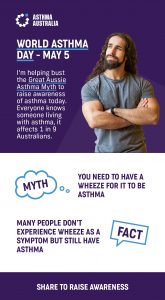World Asthma Day 2021 – ‘uncovering asthma misconceptions’.


One of our favourite days of the year is World Asthma Day (it was on May 5, 2021). World Asthma Day is held annually by the Global Initiative for Asthma (GINA) to bring global awareness to all people affected by asthma.
Asthma is of global public health importance affecting more than 339 million people worldwide (including 2.7 million Australians).
This year’s theme is “Uncovering Asthma Misconceptions”. The theme provides a call to action to address common widely held myths and misconceptions which can impact the health and day to day lives of people with asthma.
GINA found that globally the most common asthma misconceptions included:
- Myth: Asthma is a childhood disease; individuals will grow out of it as they age.
Truth: Asthma can occur at any age - Myth: Asthma is infectious.
Truth: Asthma is not infectious. Viral respiratory infections can cause asthma. - Myth: Asthma sufferers should not exercise.
Truth: When asthma is well controlled, you can exercise and perform top sport. - Myth: Asthma is only controllable with high dose steroids.
Truth: Asthma is most often controlled with low dose steroids.
In support, Asthma Australia has undertaken a local investigation to uncover the great asthma misconception affecting Australians with asthma and ways to debunk it. We received an overwhelming response from our asthma community to find the ‘Great Aussie Asthma Myth’ which is:
Myth: You need to have a wheeze for it to be asthma
Truth: Many people don’t experience wheeze as a symptom but still have asthma
So, what is wheeze? General Practitioner (GP) and Asthma Australia Professional Advisory Council member Dr Tim Senior explains that wheeze is the high-pitched noise we can sometimes hear when people breathe.
This high-pitched sound is caused by turbulent flow of air caused by narrowing, swelling and excess mucus in the airways, which is asthma. Wheeze is not an exclusive sign of asthma. Wheeze can also be common in kids with respiratory infections and in people with other forms of long term respiratory or lung illnesses.
Asthma Australia Senior Manager Nigel Cooper sat down with GP Dr Tim Senior to completely unpack this myth, ask questions, and talk about how to approach asthma without a wheeze with your GP. Watch the video below.
Read the video summary and transcript here
For many people with asthma, this ‘wheezy myth’ is not only a cause of frustration, but also potentially deadly, which Catherine Field discovered when she took her daughter to the doctor.
“My child is not always an audible wheezer – she is a silent sufferer,” Catherine said.
“One time, we were with our GP and she was having a severe attack, so they called an ambulance. When they arrived, she wasn’t wheezing and they assumed she was ok, this was until they listened to her lungs.”
Adelaide woman, Emily, has asthma and has also felt the weight of the ‘wheeze myth’. “It is so hard to get people to understand that a flare-up is physically exhausting,” she said. “They don’t seem to realise asthma is life or death.”
To help raise awareness this World Asthma Day, Asthma Australia is encouraging people with asthma to start a conversation with their friends and family about how asthma and common asthma myths impact them.
Keep an eye on our Facebook, Instagram, and Twitter pages for how you can help us debunk asthma myths this World Asthma Day.
Share this on social media
Share the above graphic with your friends, family, and colleagues across your social media channels to raise awareness of asthma. Feel free to use this text or craft your own:
It’s World Asthma Day! Everyone knows someone with asthma which affects 1 in 9 Australians. We’re raising awareness for people with asthma today by busting the Great Aussie Asthma Myth! Share this graphic with a friend to show your support for @AsthmaAustralia #WorldAsthmaDay https://bit.ly/3eNeQWX







